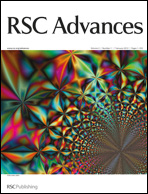Design, testing and characterization of innovative TiN–TiO2 surfaces inactivating bacteria under low intensity visible light
Abstract
Ti was sputtered in a plasma chamber under a N2 atmosphere, depositing TiN films on polyester fibers. These films show a significant adsorption in the visible spectral region. A TiN layer 50 nm thick sputtered for 3 min under low intensity/actinic visible light led to the fastest bacterial inactivation (120 min). These innovative TiN nanoparticulate films were characterized by


 Please wait while we load your content...
Please wait while we load your content...